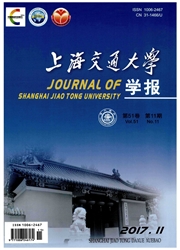

 中文摘要:
中文摘要:
提出了一种基于网络特性的单天线媒体接入控制(STNC—MAC)协议用于认知无线传感器网络.该协议能使作为次用户的无线传感器节点有效地对主用户使用信道进行机会接入.STNC—MAC充分考虑了主用户和次用户的网络特性,通过定义数据传输单元和最大信道占用时间。设计出适用于STNC—MAC的数据传输方案和可用信道列表管理机制,克服多信道隐藏终端问题和“盲”状态问题;同时,在不对主用户造成严重干扰的情况下,实现了不同主用户信道利用率的数据信道支持不同长度数据包传输的功能.NS2仿真结果表明,STNC—MAC在吞吐量和平均时延方面比STDCA—MAC和原始的IEEE802.1lMAC更好地提高了网络性能.
 英文摘要:
英文摘要:
This paper proposed a single transceiver and network characteristics based MAC protocol (ST- NC-MAC). The cognitive MAC can make wireless sensor nodes with single transceiver opportunistically access the licensed spectrum. STNC-MAC takes the network characteristics of both PUs (primary users) and SUs (secondary users) into consideration sufficiently. By defining the concepts of data transmission u nit and maximum channel occupation period, STNC-MAC developed its data transmission pattern and a vailable channel table management mechanism to solve the multi-channel hidden terminal problem and blind state problem. Additionally, the packets transmission of different lengths is supported by using the chan nels of different PUs utilizations, causing no or limited interference to PUs. The NS2 simulation results show that STNC-MAC outperforms STDCA-MAC and IEEE 802.11 MAC in terms of throughput and average transmission delay.
 同期刊论文项目
同期刊论文项目
 同项目期刊论文
同项目期刊论文
 Bandwidth Allocation and Admission Control Scheme Based on Nash Bargaining Slolution for WiMAX Syste
Bandwidth Allocation and Admission Control Scheme Based on Nash Bargaining Slolution for WiMAX Syste Handover Improvement Based on Cost Function and User fairness for Cellular Relay Enhanced LTE Networ
Handover Improvement Based on Cost Function and User fairness for Cellular Relay Enhanced LTE Networ Distributed Multisource Transmission in Wireless Mobile Peer-to-Peer Networks: A Restless Bandit App
Distributed Multisource Transmission in Wireless Mobile Peer-to-Peer Networks: A Restless Bandit App Resource Allocation for Load Balancing and Fairness Improvement in Relay-Assisted OFDMA Cellular Net
Resource Allocation for Load Balancing and Fairness Improvement in Relay-Assisted OFDMA Cellular Net Optimal energy-efficient power control for cognitive radio based on static and dynamic features of p
Optimal energy-efficient power control for cognitive radio based on static and dynamic features of p Performance evaluations of an IDMP-based macro-mobility management in heterogeneous wireless network
Performance evaluations of an IDMP-based macro-mobility management in heterogeneous wireless network Q-Learning based Heterogeneous Network Self-Optimization for Reconfigurable Network with CPC Assista
Q-Learning based Heterogeneous Network Self-Optimization for Reconfigurable Network with CPC Assista A Novel Vertical Handoff Algorithm Based on Fuzzy Logic in Aid of Grey Prediction Theory in Wireless
A Novel Vertical Handoff Algorithm Based on Fuzzy Logic in Aid of Grey Prediction Theory in Wireless Practical Robust Uplink Pilot Time Interval Optimization Scheme for time-division multiple-input- si
Practical Robust Uplink Pilot Time Interval Optimization Scheme for time-division multiple-input- si Q-learning for Dynamic Channel Assignment in Cognitive Wireless Local Area Network with Fibre-connec
Q-learning for Dynamic Channel Assignment in Cognitive Wireless Local Area Network with Fibre-connec Outage capacity of cognitive radio in Rayleigh fading environments with imperfect channel informatio
Outage capacity of cognitive radio in Rayleigh fading environments with imperfect channel informatio 期刊信息
期刊信息
